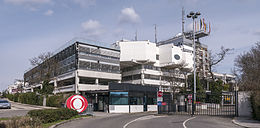ORF center Küniglberg
The ORF center in Küniglberg is the headquarters of the Austrian public broadcaster ORF. The building complex is located in the 13th district of Vienna Hietzing , on the Küniglberg about 1.5 kilometers southwest of Schönbrunn Palace .
history
In 1940 the anti-aircraft barracks Küniglberg was built on the site , which was destroyed before the end of the war. In the years after 1945 a camp for bombed-out families was set up. In 1967, the Küniglberg was selected as the location for a new company headquarters of the ORF because of its ideal traffic situation in the catchment area of the west and south autobahns , but above all because of its excellent suitability for radio relay applications. In 1967 Roland Rainer , who already had experience with large buildings and was the chairman of the jury in the architectural competition for the ORF regional studios, was awarded the contract to design an ORF television center. When work on the ORF center began in 1968, the ruins of the flak barracks were still there. From 1972 to 1975 the complex was gradually put into operation. A construction worker was killed in a ceiling collapse during construction in April 1973. In 2007 the building was placed under monument protection.
The attachment
The building, which has many unplastered and unclad prefabricated elements and is based on industrial and functional buildings, can be assigned to post-war modernism . It comprises a central equipment complex, a seven-storey main wing for administration, two large production studios with 400 m² each, a smaller one with 64 m² and a 1,500 m² television theater (Studio Z1) that can accommodate 500 people and is also the largest television studio in Austria. Around 1,300 employees work in the building every day, and because of the seclusion from the city center, there are various infrastructure facilities such as a supermarket and a post office, as well as a bank and a police station until a few years ago. The ZDF studio Vienna is sub-tenant in the ORF center.
Current discussion
The ORF center was planned economically according to the standards of the late 1960s, before the first oil shock , and executed without the use of high-quality materials. After 35 years of intensive use, it has reached the end of its life. A renovation would cost up to 50 million euros, which among other things has to do with the asbestos still present in the walls . The symbolism of the "media castle", which is expressed in the synonym of "Küniglberg" with "ORF", seems to be out of date in the media landscape at the beginning of the 21st century. At the time of its establishment, state broadcasting monopolies were common in almost all of Europe, the ORF faced no competition.
A relocation to areas closer to the center with good connections to public transport will be discussed controversially in 2012 in the highest ORF committee ("Foundation Council"). The protection by the Federal Monuments Office stands in the way of a "radical solution" with complete demolition of the building and a correspondingly profitable exploitation of the high-quality location.
In 2014, it was decided to merge all Vienna ORF locations on Küniglberg according to designs by the Austrian architects Riepl / Kaufmann / Bammer, which should be completed by the end of 2021.
Web links
Individual evidence
- ^ Hellmuth Andics, Viktor Ergert, Robert Kriechbaumer: 50 years of broadcasting in Austria. Volume IV: 1967–1974, Salzburg 1985.
- ↑ http://www.ots.at/presseaussendung/OTS_20050820_OTS0004
- ^ Courier accessed on July 12, 2015
- ↑ ORF Vienna accessed on August 12, 2019
Coordinates: 48 ° 10 ′ 39.7 ″ N , 16 ° 17 ′ 25.9 ″ E

